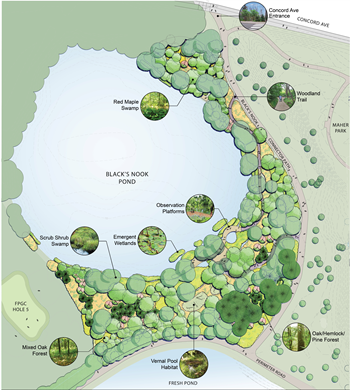The Fresh Pond Reservation Master Plan identified Black's Nook watershed management, in-lake water and habitat improvements, and shoreline stabilization very high priority. In response, the multi-phase Black's Nook Restoration Project aims to increase wildlife habitat value and water quality by fostering native wetland and woodland plant communities and stabilizing the shoreline with native vegetation, coir logs, and erosion control matting.
CWD began Phase 4, an in-lake water, sediment, and surrounding habitat study the week of 9/23/2019. The project team consisting of Hatch, Normandeau Associates, and Water Resources Services (WRS) will characterize the in-lake and surrounding environment and produce a report to inform on-the-ground management options. Please see Hatch's introductory and other presentations in the "Documents" tab.
The project team has been working with the Water Dept. to safely assess and characterize Black's Nook water, sediments, flora and fauna, and habitat value throughout the pandemic. Additional sediment sampling was conducted 7/19/2021. Remaining tasks include wetland delineation, public meetings, and permitting, and construction.
The Black's Nook shoreline and habitat restoration portions (Phases 1 & 2) of the project were completed in 2011. In ongoing Phase 3, CWD is working with volunteers from the Fayerweather Street School and others to remove invasive species and plant appropriate, native species of high ecological value in the northern and western quadrants of Blacks Nook.
Phase 4 Schedule (updated 8/24/2023)
Fall 2019 - Summer 2020 - Conduct Black's Nook Assessment/Ecological Study - Completed
Summer 2021 - Additional sediment sampling. Finalize and share final report to include assessment results and management opportunities, estimated costs, & recommendations - Completed
Anticipate pursuing the 2' dredge option in the next 3 - 5 years
The goals of the Black's Nook Restoration Plan included improving wildlife habitats, restoring native species communities, enhancing water quality, providing accessibility, and enhancing educational opportunities. Completed in the summer of 2011, the project successfully restored Black's Nook to an easily accessible diverse wildlife sanctuary.
In order to enhance the use of the pond as a natural resource study area for children, the plan included a redesigned woodland trail using porous pavement, observation platforms, and an elevated wooden path. By widening paths and improving the Concord Avenue entrance, this completed project allows for universal accessibility while also preserving the sense of wildness that makes Black's Nook unique.

Have questions or comments about the Black's Nook Restoration Project? Email us.